1000 Watt Inverter for a Roadtrek
We purchased a used 1996 RT Popular which did not have a
generator.
After spending a month
boondocking in Baja we realized that we really did not want a
generartor.
Actually I have a 3.6 KW
generator that fits on the rack in the rear but we do not plan to
take
it with us.
The down side of no generator is the loss of the microwave and the
air conditioner. Mexico as well as
much of the West Coast gets cold in the evenings so we really do
not
plan to use the air conditioner. The
microwave would be useful at times so this was a loss.
Costco was selling a 1000 Watt inverter so I checked the small
Panasonic
microwave and it was listed as 990 Watts.
There is some question as to whether this is cooking wattage or
the
wattage that is drawn from the line but I did not
know this until later. If your microwave takes more wattage
don't
give up. You can purchase this type of inverter
in several larger sizes.
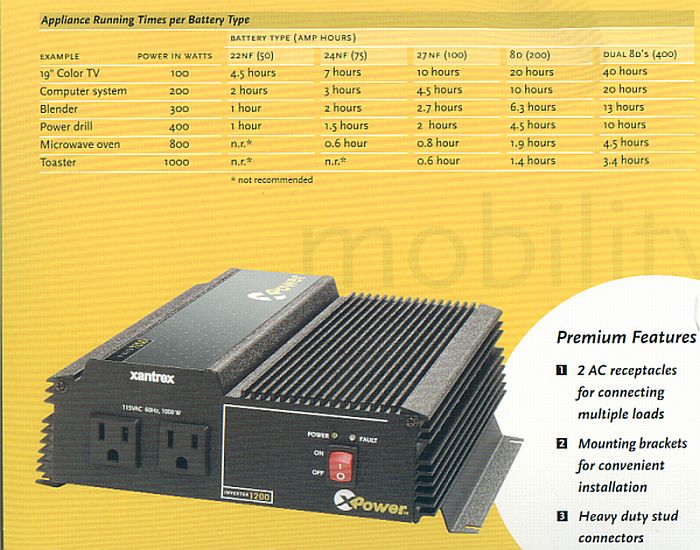
The next question is which battery should this be powered from?
The
house battery would seem the logical choice
but when you figure the current plus 10% loss in the inverter, it
will
require at least 90 Amps. Without a generator
the house battery will not last very long. The second choice
would be the engine battery. The problem is you can
easily run the battery down far enough that you cannot start the
engine.
The next thought would be to start the engine first and use the
alternator
to charge the battery as you are running the
microwave. The Dodge engine is probably less noisy than many
generators. I did some checking and found that
the Dodge alternator is good for 120 Amps so this looks like it
will
work. I purchased the inverter and connected it
directly to the engine battery. I then used a drop cord to
connect
it to the microwave. It started and ran the microwave
just fine. When the engine is running the battery voltage
drops
to 12.5 Volts. This means that the alternator can supply
all the current so you can run this setup as long as you have fuel
for your van.
The next trick was to figure out how to wire this all into the
Roadtrek.
The instructions say that the inverter should be
5 feet from the battery. The recommended wire is #2 so it is
big and ugly to route. I decided to place the inverter in the
outside
cabinet just behind the drivers seat. It is bolted to the
top
of the cabinet with the 12 volt connections pointing forward.
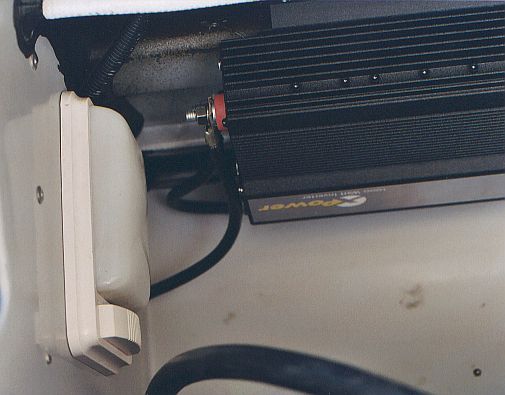
Here is the inverter from the other end.
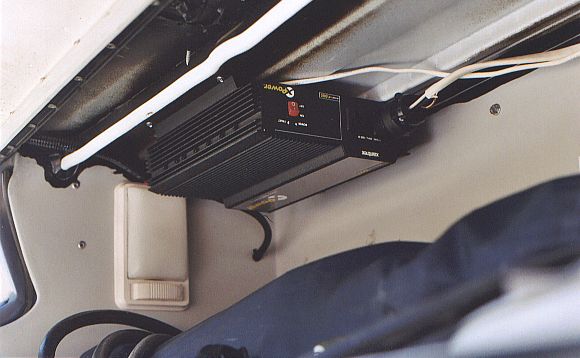
Just to make sure that the van does not burn burn up if there is a
problem, I added a 200 Amp fuse at the battery.
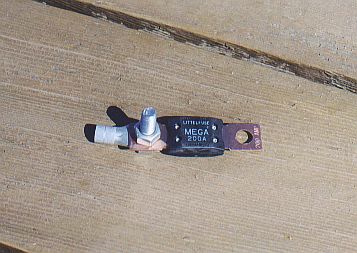
Here it is in location.

The wire follows the starter wire down and then goes behind the propane
tank
and into the end of the cabinet. The ground wire
is only about 8 inches long as I used an existing bolt in the back
of the cabinet to bolt it to the frame.
On the output I had two choices. You can build or buy a
transfer
relay or add another electrical box next to the one on the
wall below the microwave. I chose the transfer relay. It
came from my junk box but the number on it is D26MB.
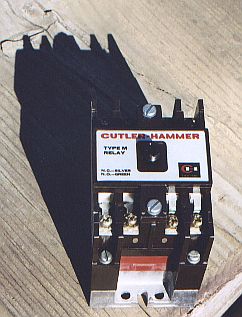
I removed the wire that normally feeds the microwave from the converter
and
connected it to the relay. I then
connected the inverter to one side and a new wire from the
converter
to the other side. The coil on the relay was 110 Volts
AC so it was connected across the output of the inverter.
When
the inverter comes on it switches the relay over to the
inverter. When the inverter is shut off the relay drops back
to the other state and the microwave is powered by the converter.
Here is an electrical diagram on how this all works.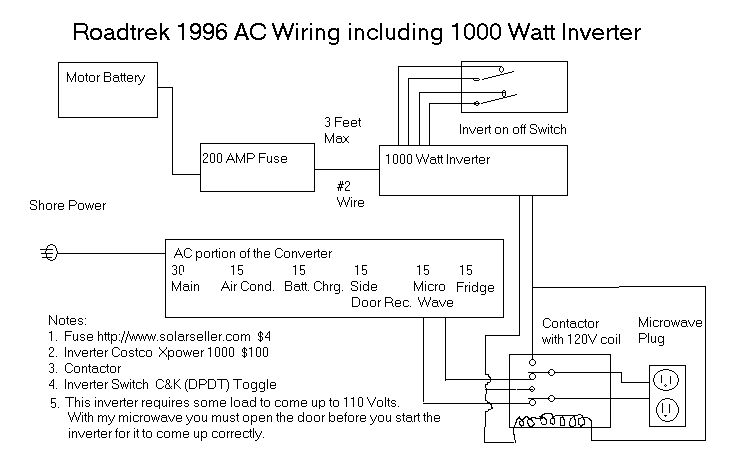
The inverter comes with or without an external on off switch.
Mine
did not have it so I just paralleled up another switch
and made a hole for the wires through the grill on the back.
Both
the output of the inverter and the switch wire were run
along the back of the side cabinet and up into the bottom of the
refigerator
cabinet.
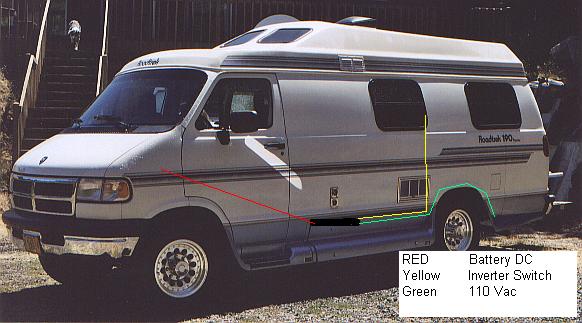
I then drilled a hole through the lower edge of the refigerator cabinet
into
the back of the cabinet that has the first drawer.
I pulled the wire up over the wheel well and placed it behind the wall
board.
It then came down into the electircal cabinet
where it connected to the relay.
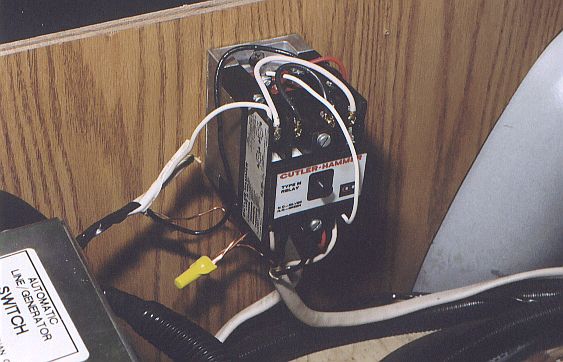
The switch wire went up the corner of the refigerator cabinet to a
little wooden box at the back end of the kitchen window.
The switch was mounted by drilling a 1/4 inch hole in the front
panel
of the little wooden box. The switch is the only visable
item on this system when the outside cabinet is closed.
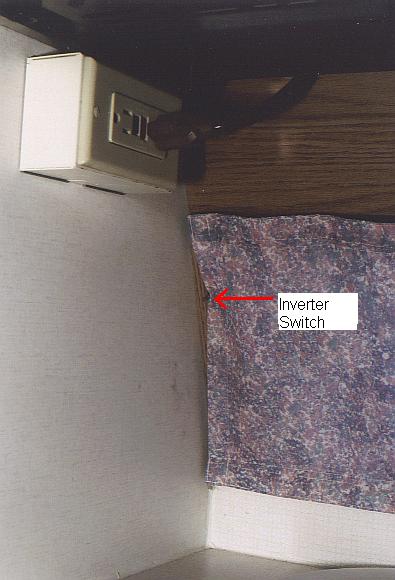
Now for the one problem I ran into. Sometimes when you flip
the
switch, the relay closes, and the power comes on to the
microwave, but the clock does not light up. If you open the
door
the light comes on and the dish starts to turn. After some
testing I found that the inverter likes to see some amount of load
to come up fully to 110 Volts AC. If you open the door
before you turn on the microwave, the light seems to be enough
load
to make it start correctly.
This may not be a project that everyone would want to do themselves
but
there are lots of van conversion companies that
would be glad to add this type of setup.
Back









